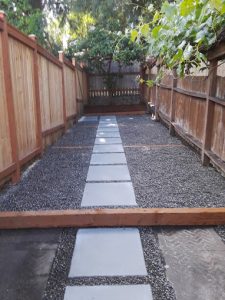Pressure Washing Pavers: A Simple Guide to Restoring Your Outdoor Spaces
Hey Seattle! Mr. Lee here, your neighborhood landscape contractor, ready to help bring your outdoor spaces back to life. If you’ve got a driveway, patio, or walkway made of pavers that’s looking a little worn out, pressure washing might just be the solution you need. In this guide, we’ll break down everything you need to know about pressure washing pavers—from why it’s a great idea to the tools you’ll need and the best practices for a sparkling clean finish!
Why Pressure Wash Your Pavers?
Before diving into the process, let’s talk about the why behind pressure washing pavers. Over time, dirt, grime, moss, and even oil stains can accumulate on your pavers, making them look tired and faded. Pressure washing is an effective way to restore the appearance of your pavers and prevent long-term damage. Here’s why it’s worth the effort:
- Remove Stubborn Stains: Pressure washing blasts away dirt, algae, and stains that have built up on your pavers.
- Restore Vibrancy: Regular cleaning can bring the colors of your pavers back to life, enhancing the overall look of your outdoor space.
- Prevent Mold & Mildew Growth: Dirt and moisture can lead to mold and mildew growth, especially in shaded or damp areas. Pressure washing helps prevent this buildup, keeping your pavers in great condition.
How Does Pressure Washing Work?
Pressure washing uses high-pressure water to clean surfaces. When applied properly, it can remove dirt, stains, and debris without damaging the surface. Here’s the step-by-step process to get your pavers looking like new:
- Preparation:
Start by clearing the area of any furniture, plants, or other objects that could be in the way. Sweep or blow away loose debris to ensure the surface is clean before you start pressure washing. - Select the Right Pressure:
Pressure washers have adjustable pressure settings. For pavers, you’ll want to use medium pressure to avoid damaging the surface. Too high of pressure can crack or chip the pavers, while too low might not clean effectively. - Apply Cleaner (Optional):
If your pavers are particularly dirty or stained, you may want to apply a cleaning solution designed for use on pavers. Be sure to check that the cleaner is safe and recommended for your type of pavers. - Pressure Wash:
Begin pressure washing at one end of the area and work your way across. Use a sweeping motion, slightly overlapping each pass to ensure even cleaning. Keep the nozzle at least 6 inches away from the surface to prevent any damage. - Rinse:
After pressure washing, rinse the pavers with clean water to remove any leftover cleaner and debris. This ensures a streak-free finish. - Allow to Dry:
Let the pavers dry completely before placing furniture or walking on them. This allows the surface to fully settle and the cleaned area to harden.
Tools You’ll Need for Pressure Washing Pavers
Here’s a list of tools that will make your pressure washing job easier:
- Pressure Washer: You can rent or buy one, but make sure it has adjustable pressure settings to match your needs.
- Surface Cleaner Attachment: This attachment helps you clean large areas quickly and provides an even, uniform clean—perfect for patios or driveways.
- Broom: Use a broom to sweep away loose debris before you start pressure washing.
- Garden Hose: For rinsing the area and applying cleaning solution if needed.
- Protective Gear: Always wear gloves, goggles, and sturdy shoes to keep yourself safe from debris and water pressure.
Best Practices for Pressure Washing Pavers
To get the best results and avoid damaging your pavers, follow these best practices:
- Test First: Always test the pressure washer on a small, inconspicuous area first to ensure the pressure won’t damage the pavers.
- Don’t Overdo It: Using too much pressure can harm your pavers. Stick to a medium pressure setting, and adjust it as necessary depending on how dirty the surface is.
- Watch the Grout: If your pavers are set in sand, be cautious not to wash away too much of the sand between the pavers. Consider re-sanding them if necessary.
- Clean Regularly: Regular cleaning (at least once a year) helps prevent dirt and stains from settling in, making your pavers easier to maintain.
- Seal After Washing: After pressure washing, consider sealing your pavers to protect them from future stains, moisture damage, and wear.
Wrapping It Up: Pressure Washing for a Cleaner, Fresher Yard
Pressure washing your pavers is an easy and efficient way to maintain your outdoor spaces. By following the right steps and using the proper tools, you can restore the beauty of your pavers and extend their lifespan. Whether you’re prepping for summer barbecues or simply freshening up your driveway, pressure washing can make a big difference.
If you need help with pressure washing or any other landscaping tasks, don’t hesitate to reach out. Mr. Lee is here to keep your Seattle landscape looking its best—one paver at a time.



















